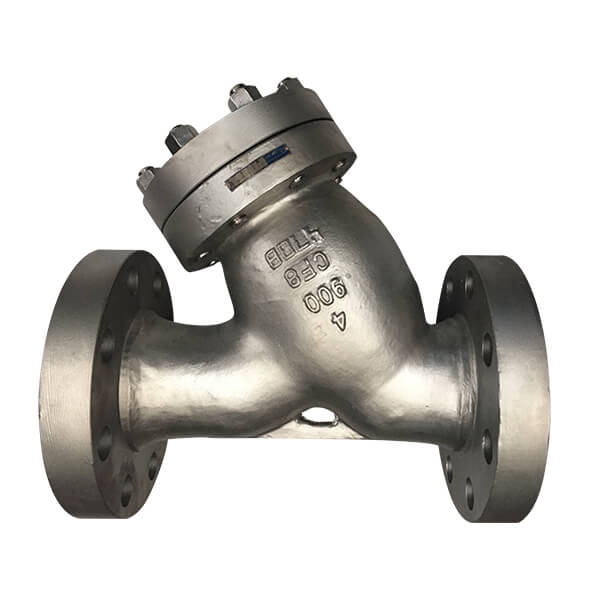A Y-strainer is an indispensable filter device in the pipeline system for conveying the medium.
What is a Y Strainer?
Y strainers, also known as wye strainers, are shaped like a “Y” and install inline to prevent solids, pipe scale, rust, and debris from mixing into liquid, gas, or steam in a flowline. Y strainers use perforated or wire mesh straining screens and install vertically or horizontally to protect pumps, meters, control valves, steam traps, regulators, and other process equipment. These strainers are available in a variety of sizes and materials.

Design of Strainer Y Type
As its name implies, a Y strainer is shaped like a “Y and is used to filter, or strain, out particulates from steam, gas or liquid. This mechanical straining process is made possible via a filter element comprised of mesh, perforated metal, or a wedge wire straining element. The most common kind of straining element is a wire mesh. Some also include “blow-off valves that make the cleaning process easier in applications with more substantial dirt blowing. The strainer itself has a compact, Y shaped design. The Y shape has better flow characteristics then for example a T shaped strainer, because the fluid flows through the filter with less change of direction.
Purpose of Y Type Strainer
The y strainer purpose is to remove unwanted particles from steam, gas, or liquid using a straining element typically made of wire mesh. Using this mechanical process in pipelines helps to protect everything from pumps to steam traps. Y strainers are sometimes designed with “blow-off valves” to make the cleaning process easier.
Perhaps the largest benefit that comes from the y type strainer is its flexibility. It can be installed in a vertical or horizontal position, depending on the users’ preference. While this strainer type is already a cost-effective option, the size of y strainers can be reduced to save even more money. This also prevents using excess materials. Y strainers can be made of a variety of materials. The type of material you choose depends on the industry and application that is used. Any type of end that you might need is available as well. From socket to flanged, there is a y strainer out there with the end you need!
The ways in which y strainers can be customized are seemingly endless when compared with other types of strainers. However, the design of a y strainer must be appropriate for the application for this system to be successful. In order to get the right results, always be sure to know the application you are working with before buying a y strainer.
Y Strainer Mesh
| Mesh Screen | Mesh Size | Microns |
| 2000 | 10 | 0.0787 |
| 1680 | 12 | 0.0661 |
| 1410 | 14 | 0.0555 |
| 1190 | 16 | 0.0469 |
| 1000 | 18 | 0.0394 |
| 841 | 20 | 0.0331 |
| 707 | 25 | 0.028 |
| 595 | 30 | 0.0232 |
| 500 | 35 | 0.0197 |
| 420 | 40 | 0.0165 |
| 354 | 45 | 0.0138 |
| 297 | 50 | 0.0117 |
| 250 | 60 | 0.0098 |
| 210 | 70 | 0.0083 |
| 177 | 80 | 0.007 |
| 149 | 100 | 0.0059 |
| 125 | 120 | 0.0049 |
| 105 | 140 | 0.0041 |
| 88 | 170 | 0.0035 |
| 74 | 200 | 0.0029 |
| 63 | 230 | 0.0024 |
| 53 | 270 | 0.0021 |
| 44 | 325 | 0.0017 |
| 37 | 400 | 0.0015 |
Applications of Y-Strainer
Y-Strainers are very cost effective straining solutions in many applications. Where the amount of material to be removed from the flow is relatively small, resulting in long intervals between screen cleanings, the strainer screen is manually cleaned by shutting down the line and removing the strainer cap. For applications with heavier dirt loading, Y-Strainers can be fitted with a “blow-off” connection that permits the screen to be cleaned without removing it from the strainer body.
Y-Strainers are used in a wide variety of liquid straining applications to protect downstream process system components in many industries, including: chemical processing, petroleum, power generation and marine. Water handling applications, where Y-Strainers are used to protect equipment that could be damaged or clogged by unwanted sand, gravel or other debris, are very common.
While often used in many different types of liquid applications, a Y-Strainer is considered the standard for steam applications and is almost universally used for these applications. Its compact, cylindrical shape is very strong and can handle high pressures. It is, literally, a pressure vessel. Y-Strainers which handle pressures up to 6000 psi are not uncommon. Of course, in these cases, the design of the strainer is critical so that it can stand up to these high pressures without fear of failure. When high pressure steam is being handled, another complicating factor arises, temperature. With steam pressures of 1500 psi or higher, standard carbon steel is sometimes not suitable because the steam temperature may be 1000° F or higher. In these cases, the Y-Strainer body is generally made of chrome-moly steel.
Besides steam, Y-Strainers are often used in air and natural gas applications. Here again, high pressures are not uncommon. However, unlike steam high air pressure does not automatically mean high temperature and so, ordinary carbon steel bodies of sufficient wall thickness will generally suffice.
Related Tags :
Ten articles before and after
Repair of Gate Valves – Zeco Valve | API 600 gate valve manufacturer
Maintenance and Quality Standards of Gate Valves – Zeco Valve | API 600 gate valve manufacturer
Repair Standards for Gate Valves – Zeco Valve | API 600 gate valve manufacturer
How to Deal with the Valve’s Corrosion? – Zeco Valve | API 600 gate valve manufacturer












